It’s molting season. The chickens are looking scruffy.
The hens are stressed. Some have come out of weeks-long broody spells, only to head right into the molt. Others have been laying so steadily all summer that now they are depleted of nutrients. All chickens over a year old are losing their feathers. Replenishing their bodies and growing new plumage takes a lot of energy, protein and calcium. You see your girls looking like this and you want to do something.
During this time, hens need an optimum diet. Continue to feed high-quality laying hen pellets and avoid empty-caloried treats, like handfuls of cracked corn and stale bread. You can purchase laying hen pellets that are designed especially for molting season with nutrients added that promote feather growth. I’m not convinced that this expensive feed is worth the cost. (Skeptical me thinks that the manufacturers are catering to the owner’s worries more than what is actually necessary for the flocks.) I caution against feeding a lot of high protein treats, like mealworms, because chickens will gorge on them whether they need them or not, and excessive protein causes kidney failure.
I do what farmers did back before supplements. I feed alfalfa. Alfalfa looks like hay (which is a grass), but it’s not. Alfalfa is a legume. It’s packed with digestible (for chickens, not you!) protein and calcium. There is evidence that feeding alfalfa reduces the amount of salmonella in a hen’s gut. The difficulty for the urban and backyard chicken keeper is finding it in a form that you can handle and bring home. Pellets are convenient, but they are formulated with more stem than leaf, and what the hens require are those nutrient-dense leaves. A small box of alfalfa, sold in the rabbit section of the pet store, is very expensive and wouldn’t last a week. A bale at the feed store usually weighs over a hundred pounds! But, you can find what you need in the horse aisle: chopped alfalfa mixed with molasses. (This is horse feed, the molasses makes it more palatable for the animals; the hens don’t mind.)
This is the brand that I feed – it comes in a 40 pound plastic bag, the size and heft of a bag of pine shavings. Every morning, I toss a handful out into the run. Because the stems are chopped, your hens won’t get impacted crops. They like it enough, but don’t eat too much. They look for the leafy bits and ignore the rest. What they don’t eat is quickly scratched into the ground and improves the soil. Here, Ruby is finding the best pieces. She is a superb layer who hasn’t yet begun to molt.
Jasper, however, is another story. This head shot shows the few remaining feathers falling out, and the new quills coming in.
Here’s a view from another angle. Oh, Jasper.
It’s a good thing for her that she likes the alfalfa. Eat up, girl.
I started feeding Lucerne Farms alfalfa in early August, when I first noticed thin-shelled eggs. The hens already had free-choice oyster shell and an excellent diet, but their fragile eggs were breaking in the nesting boxes. Within a few weeks of feeding alfalfa, the shells thickened up.
Now that we’re halfway through October, there are fewer eggs for the hens to put their resources into laying, but many feathers to be built. Hens like Jasper could use help! Once the molt is over, I’ll continue to feed alfalfa through the winter when the girls will appreciate the green tidbits. So, my hens get alfalfa, but my horse does not. Alfalfa is too rich for him – Tonka eats classic timothy hay (he is indulged with carrots and peppermint candy.)
UPDATE: please read this post as well. Roughage can cause issues. Make sure that you feed grit and that your hens aren’t eating alfalfa to excess.
(FYI, I stumbled upon the Lucerne Farms alfalfa at a horse expo, and I asked them for a bag of their alfalfa to try. So, I did receive free product for this post, but I was not paid for a positive review. I have tried products by other companies that I have not endorsed.)
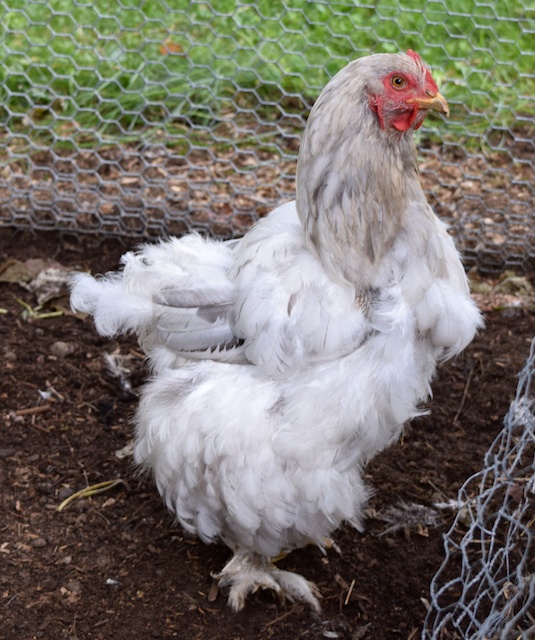


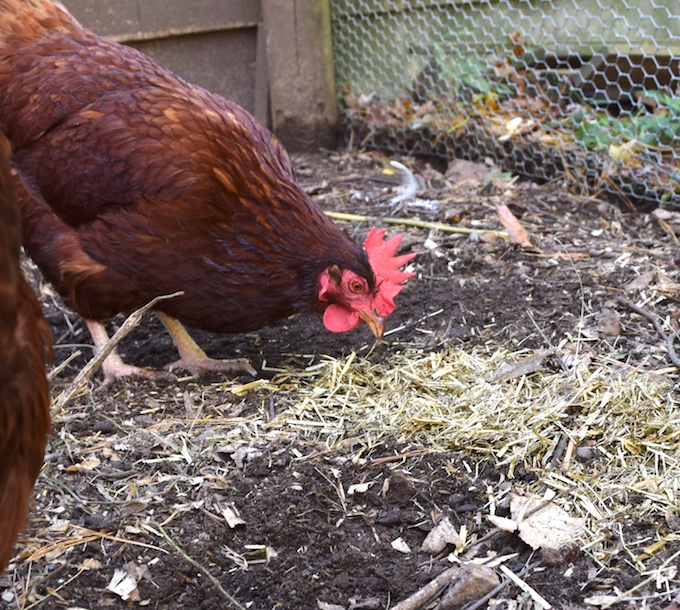
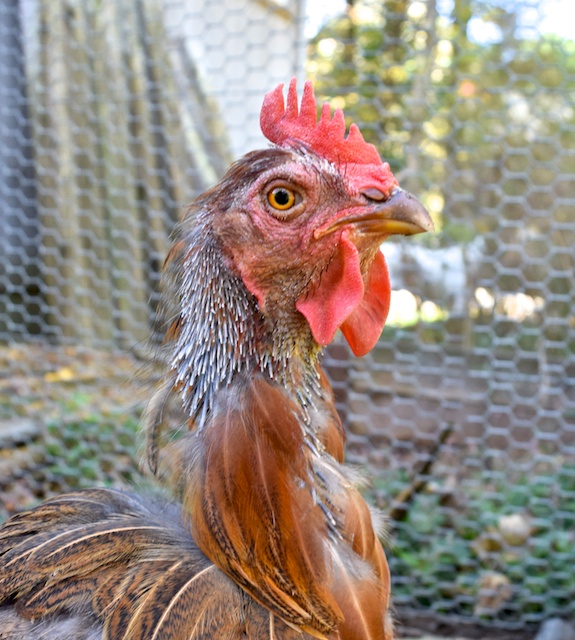
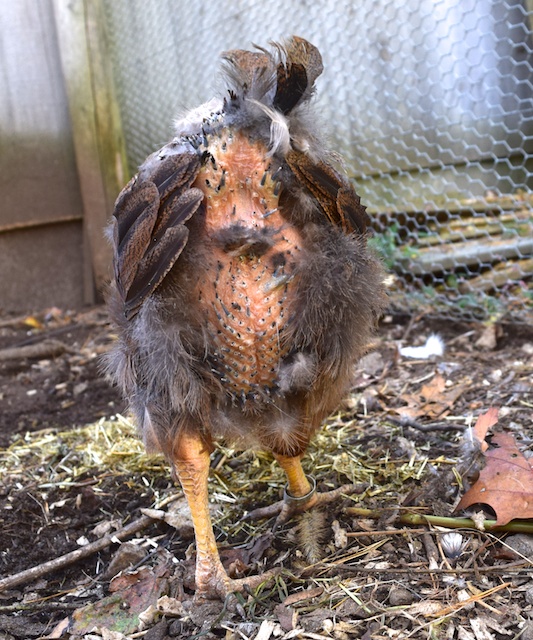
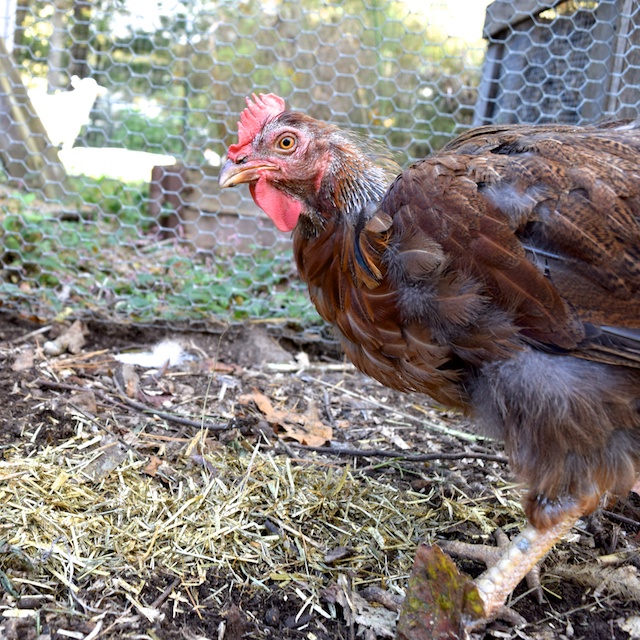


Great post. Thanks as always. My new hamp red has dropped only afew feathers and is still laying steadily. My glw are starting to molt but still saying. My ee barely went through a molt last year and doesn’t show any signs so far. However she only lays every other day as usual. On the other hand my unusual breeds:Belgan duccles, marans and welsummer are looking like your Jasper ….poor girls. They will get some alfalfa. Hope my local store will carry it.
Hens are unable to synthesize all the necessary amino acids from plant protein. Having some animal protein containing the ones they can’t make helps them feather out. But the animal protein supplementation should not exceed 10% of total feed.
I feed organic alfalfa pellets soaked to a mash every day. Twice a week they are soaked in the whey from my cheese making. But every day they get 1/4 oz/bird of ground ocean going fish (usually pollock) for the animal protein. This is well under the 10% but satisfies the need for certain amino acids.
Removing the animal protein from poultry feed due to mad cow in the 90’s was not a good move, chicken health wise. Prior to that, poultry feed always had animal protein.
How you feed your hens is conscientious, but well beyond what most of us can or want to do. Commercial laying hen pellets have a synthetic protein, not as good as your fish, but the hens do fine on it. This time of year the girls are still foraging and eating insects. Excellent protein.
Thanks for this timely post, Terry! I have been trying to think ahead to winter run management, how to meet my hens nutritional needs when there are no longer many bugs to be had, and how to keep them occupied in the run during the day. This is a great solution, and, like MicheleB, I hope my feed store carries it in the form you recommend.
p.s. Poor Jasper – that is one extreme-looking molt! Hopefully she will be feathered in again soon.
Thank you for posting this. Question, We have a rabbit so we already buy alfalfa or timothy hay for her. Could I try my chickens out with what I have to see if it is something they would like? Or- Is it not a good idea because it doesn’t come chopped up like the one you have shown?
Thanks in advance!
Julie
My hens are around hay because of the goats and rabbit. There’s always a danger of impaction from tough, long-stemmed plants. However, because my hens have plenty of choices they don’t indulge. Still, it is better to offer chopped forage to limit the risk.
Great read, just what I was looking for. My fav Blue hen, Falcon (kids named her), is molting for the first time. She is 5 years old. Heading to TSC for some bagged alfalfa. I never buy it, I’m always afraid someone will mistakenly feed it to my horses. Lol. A bag of it would be great. Girls (and guy) will be most happy.
I can assure you that your hen has molted each of the previous years. Some hens don’t show their molts- my buff orpingtons always look lovely, but I know they molt because I find their feathers. In any event, I suggest putting it in a galvanized can and labeling it so that your horses don’t get it.
Amazing how the moult works…..My Jersey Giant looks as pristine and beautiful as ever but every a.m. there is evidence by way of huge pile of black feathers on coop floor that she is indeed moulting. The Ancona was my most pathetic looking hen so far this year. She was early so is now back to her usual dashing good looking self, complete with screaming red floppy comb.
SUPERB PHOTOS AND ADVICE – THANKS, TERRY.
I’m raising a dozen spring-hatched pullets for the first time (I’ve always gotten point-of-lay hens, for the most part) and as they approach 4-5 months, they are all shedding TONS of feathers, but still look fine and full (no bare spots or pin feathers in sight.) I guess this is just a molt of teenage feathers, but since it’s now fall, do you think they will actually start laying when they come of age, or will they spend the winter (SoCal) growing adult plumage and not lay until spring?
Also, I still have them on grower crumbles, which are meant to be fed until 18-20 weeks old. Since they range a full month apart in age, should I feed layer crumbles now (the oldest are just 20 weeks) or wait until the youngest reach 18 weeks (Nov. 1)?
Pullets continue to shed baby feathers until they are mature. It’s not a true molt. Generally, by the time my new birds reach 16 weeks, I stop buying chick feed. When it runs out, I switch to layer. What’s critical is not to feed the babies the laying hen feed, but by 4 months it’s not such a worry.
Thanks, Terry. What about starting to feed them a mixture of the two feeds, as I am well-stocked with chick feed AND have a bunch of leftover lay feed from before the raccoon massacre. Is feed that’s been stored in a covered trash can OK after nearly 6 months? No visible mites or moths or mold….I hate to throw it out.
Give the feed a good sniff. If there’s a hint of mustiness, throw it out. If it’s been dry and protected, then it’s fine. Go ahead and mix it in with the chick feed.
I know Terry you really don’t like some online chicken forums, but have you thought of entering Jasper’s picture in the Moulting picture contest online? She might have a good chance in winning.
Also how does Phoebe like the molasses mixed alfalfa ?
As far as I can tell, Phoebe ignores the alfalfa. She likes her grass hay better.
I don’t have hens but your posts have made me wonder about wild birds. They couldn’t molt like Jasper does but perhaps they lose a few feathers at a time? Raising hens is trickier than I knew, and their wild cousins must share similar troubles.
All birds molt, and some wild ones do a complete molt like Jasper! Others do a patterned molt. Cornell provides this excellent informative page.
There’s not a store in our area that carries Lucerne…is there another brand that you could recommend?
There are many, many regional feed companies. Just ask at your local feed store if they carry chopped alfalfa. Quality hay smells fresh. There shouldn’t be any musty smell. And it should smell green!
Hello Terry! Love the photo’s. Our five hens are in full molt. Some bare bottoms out here in Denver. (Ha!) Our Coop floor is covered in a beautiful mix of feathers. Was wondering if I can leave them on the floor (we use pine shavings) and layer some more shavings over the feathers for better winter insulation. We use no heat or light in our coop, just the shavings. I also clean out the chicken droppings from the coop and run every day. What are your thoughts?
I don’t like to leave feathers about. First of all, they don’t absorb moisture. Also, they might lead to feather eating when the hens are bored in the winter. So, clean them out!
Thanks Terry! Feather collecting first thing tomorrow!
Believe it or not I found this stuff at the feed store up the street…Thanks Terry!
Some of the hens while molting turn into cranky nasty old ladies too. I have a couple Easter Eggers going through a “hard” molt and they just peck and chase the other hens non stop. They are normally gentle quiet hens.